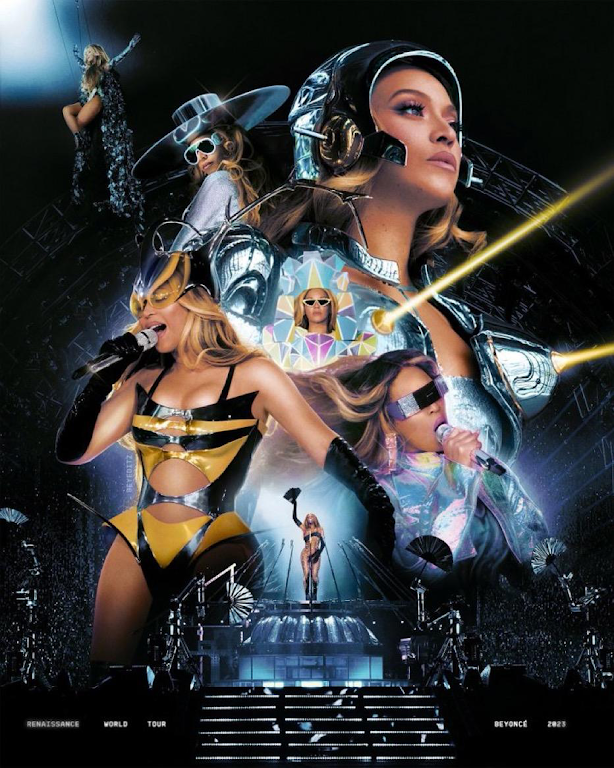A diva is the female version of a hustler…

By Amran Abdiqadir-Mohamed, BA Global Development and Social Anthropology
Is what Beyonce said as she released the superhero movie Renaissance. Ways to describe the film- intense, out of this world, iconic… a genuine religious experience. Having said all of that, when I left the screening I turned to my friend and said ‘that was a blip, I don’t think I remember much- let’s go again!’ (this article contains spoilers xx).
I’ve always considered myself a casual Beyonce fan but I’m slowly realising that I’m a certified member of the Beehive. There are so so many things to talk about and bizarrely my favourite aspect of the documentary wasn’t the concert clips. I found the film to be deeply personal and uplifting. The childhood vignettes and backstory of the album truly made me view the Renaissance era differently.
Before watching the film, I had seen a few… no why lie, many concert clips on TickTok. Lots of which had captions/comments claiming that this was a tour where Beyonce was having a lot of fun. She no longer had something to prove to the world- more specifically the western music industry. Queen B made it to the top and is now enjoying her well deserved throne.
This was a sentiment that was reflected in the documentary when Diana Ross surprised everyone by singing happy birthday to Beyonce as she turned 42 in LA (B’Day!). The moment was important for many reasons, firstly- it was super cute. Secondly, it demonstrated the intergenerational struggle experienced by black female solo musicians. Diana Ross is one of the many people who walked so Beyonce could run; something she touches upon when she expresses that her role in society is to set the stage for the next person to follow her.
The representation in Renaissance comes in layers. It wouldn’t be right to discuss the tour without talking about the brilliance that is Amari Marshall. Choreographer to Ciara, Janet Jackson, and Rihanna, Amari most recently was the Dance Co-captain of Renaissance. As a dark skin curvy woman it was wonderful to watch Beyonce give Amari her flowers in the documentary. In a recent interview with Sherri Shepherd, Amari mentions how being recognised as a leader in this space was a true demonstration of female empowerment. She shared that the impact of being the representation that she did not have growing up is important to her as a role model for the next generation; so that they can dream to take up space in the positions she struggled to see herself in. A lot of this came into her mentorship of Beyonce’s eldest, Blue Ivy.
Blue’s story is one that took me by surprise. I am sure we have all seen the videos of Blue joining her mother for ‘My Power’. In the documentary, Blue spoke about how it was her idea to perform, and she was taken aback at the intense rehearsal schedule. After her first show, one of Blue’s friends had forwarded a video of her dancing with a load of hate comments. Some of the criticisms were that her performance came across stiff and unnatural. To her credit, the 11 year old took this as motivation to work harder and improve. Initially she was only meant to join in for one show, but after the online hate, Blue was determined to perform again and again. For someone so young, I was in total shock at her maturity and it’s safe to say that by her final show… Blue ATE.
Perhaps one of the most surprising components of the documentary was finding out that the original Destiny’s Child members, Kelly Rowland, Michelle Williams, LaToya Luckett, LaTavia Roberson, and of course Beyonce Knowles had reunited for the first time since their separation. Their link up took place in Houston, Texas before Beyonce’s hometown show. On this walk down memory lane, the audience was officially introduced to Uncle Johnny… as in ‘Uncle Johnny Made my Dress!’
Beyonce and her mother Tina shared personal memories of Uncle Johnny who was an important figure in her childhood as he helped raise Beyonce and the other Destiny’s Child members. During the early years of the band, larger designers refused to style the girls as a group of ‘country black girls’ didn’t match their brand’s aesthetic. Uncle Johnny and Tina would stay up all night creating their stage costumes, sewing each and every sequin by hand. As mentor, father figure, and stylist it was clear how much Uncle Johnny meant to Beyonce. In fact, it was him who first introduced her to 80s house music where Beyonce found inspiration for the Renaissance album.
The tour, music, fashion and visuals are brilliant. This we already know. What may have escaped some people were the queer and fabulous influences that Beyonce used to create this world. From the New York ballroom scene to the experiences of her Uncle Johnny as a gay black man in 1950s America, Renaissance truly embodies a culture of resistance and joyful activism.
“My ultimate goal,” she says, “is to create a space where everyone is free and no one is judged, and everyone can be their childlike selves, their sexiest selves. They can all be on that stage. They are the vision. They are the new beginning. That’s what Renaissance is about.”
In the end, Beyonce’s Renaissance isn’t just another concert film, it’s a story filled with personal experiences, cultural influences, and moments of resilience. It’s about family, legacy, and the queer influences that shape this incredible world. As Queen B said, her goal is to create a space where everyone can be their authentic selves- let’s revel in the brilliance of the Renaissance and try to celebrate freedom and joy in our everyday lives. After all, in the world of Beyonce, every performance is not just a show; it’s a transformative experience- a new beginning.



